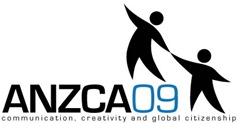
Just to reassure you all that I’ve not turned into a automated link-posting robot, I thought I’d make an actual post since I’m about to head to Brisbane for The Australian and New Zealand Communication Association 2009 conference, held at QUT this week. It should be a great conference, with a number of my Internet Studies colleagues presenting, lots of great sounding papers and the Oxford Internet Summer Doctoral Programme folks also around QUT at present, making for a pretty vibrant atmosphere, I’m sure!
For those of you interested (or looking at the 5 parallel streams of papers, trying to decide which one looks interesting) here is the abstract for my talk, ‘What Dr Horrible Can Teach Media Creators About Participatory Culture’:
During the 2007/2008 US Writer’s Guild of America strike writer-director Joss Whedon came up with the notion of a one-off online “show” made outside of the studio system, on a miniscule budget, and entirely publicised using the web and social networks. Thus, Dr Horrible’s Sing-Along Blog, a three-act online musical comedy centred on a flawed supervillian, was conceived. In promoting Dr Horrible, Whedon and his team used both official websites and presences on Facebook, MySpace, Twitter, Digg as well as engaging with Whedon’s existing legion of fans via fansites such as Whedonesque.com. Moreover, far from using these websites purely as one-way advertising delivery platforms, the producers, writers and some Dr Horrible actors engaged fans in meaningful dialogue via these platforms.
Fan discussion and remixing of the show emerged rapidly; within weeks of its release there were hundreds of fan sing-along videos on YouTube, joined by everything from fan-created artwork and wallpaper to unofficial sheet music. Far from shunning these unofficial creations, the Dr Horrible producers actively congratulated and promoted the best fan creations. Despite Dr Horrible initially being available for free in its first week, subsequent sales via the iTunes store, and later on DVD, at times rivaled all but the most successful Hollywood blockbusters. Thus, in an era where media companies and startups are increasingly becoming concerned about brand loyalty, not just Nielsen ratings, Dr Horrible may serve as a model for producers and fans interacting in mutually beneficial ways as part of participatory culture. This paper will attempt to examine the way Whedon and his team utilised participatory culture in promoting Dr Horrible, asking which elements built on the foundation of Whedon’s past successes, but even more importantly what lessons Dr Horrible has for both existing and emerging media creators.
And here are the slides I’ll be using:
I’ll probably be Twittering from the conference (Wed – Fri) and I think the default Twitter hashtag will be #anzca2009.


The talk looks really interesting. Dr. Horrible is defiantly one of the best examples of the changing media landscape and how new media creations can be successful.I’m not sure if you know or not, but Dr. Horrible is still avaliable for free on Hulu but of course only for US viewers. Curse of tyranny of digital distance strikes again.
Enjoyed the Dr Horrible presentation. Thanks. And thanks for the link to ANZCA2009, I’ve been trying to get to the website for days but with no success….always get a message saying the link is broken! Your link, though, works!
I see that Brian McNair presented. Did anyone blog his presentation?
Hi Jude – Sadly, the time for Brian McNair’s keynote was incorrect in the programme, so most of the regular ANZCA bloggers – like Axel Bruns – missed most of his session, so I don’t know of any blogged record. 🙁